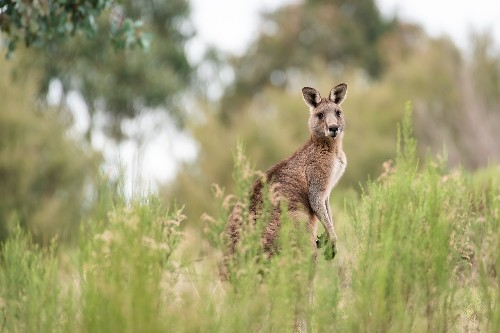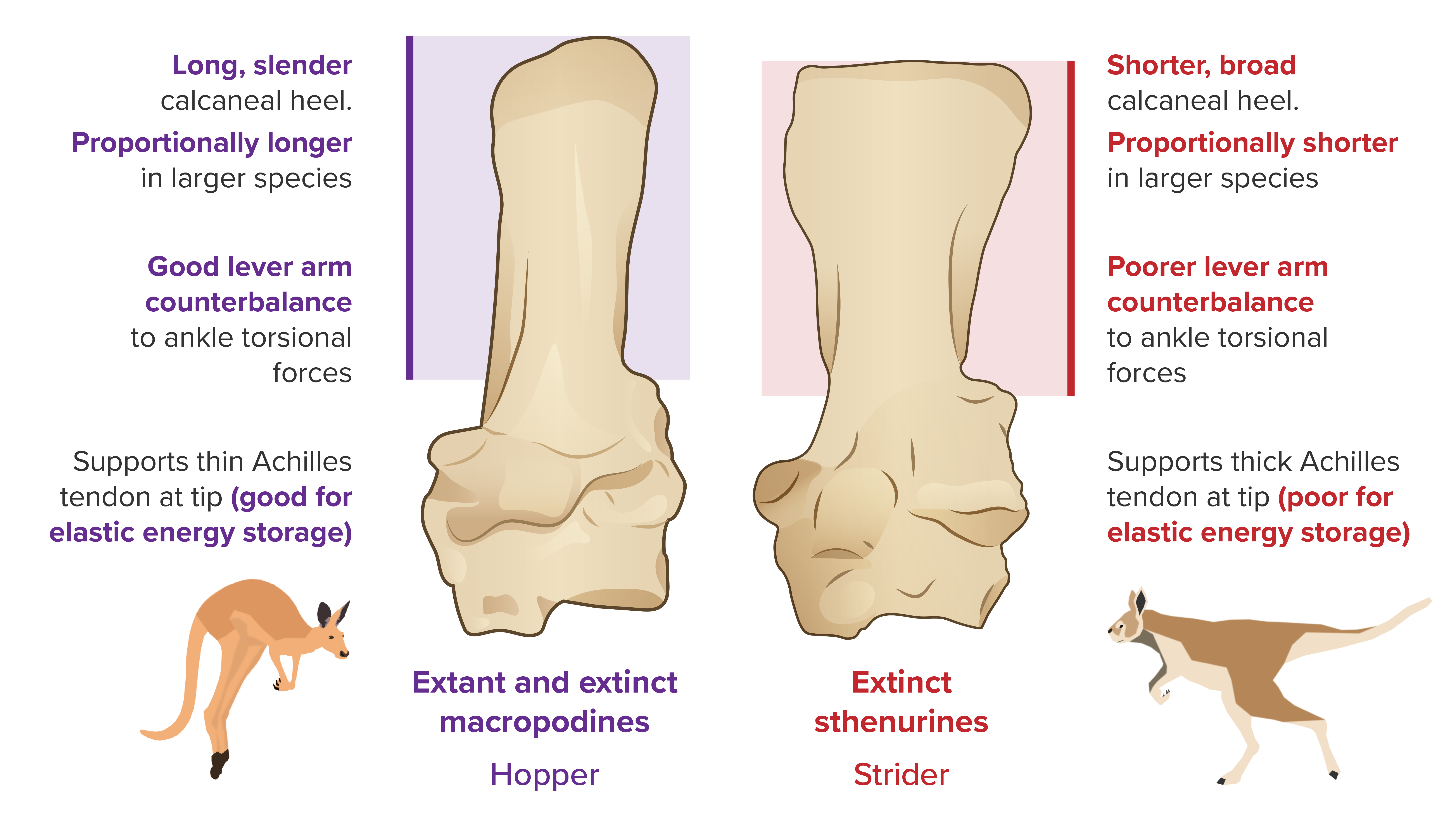Skipping Evolution: Some Kangaroos Didn’t Hop, Scientists Explain
Extinct kangaroos used alternative methods to their famous hop according to comprehensive analysis from University of Bristol and the University of Uppsala scientists.


Illustration showing difference in calcaneal heels between hopper and strider
Image credit: Nuria Melisa Morales-Garcia
Extinct kangaroos used alternative methods to their famous hop according to comprehensive analysis from University of Bristol and the University of Uppsala scientists.
Although hopping is regarded as a pinnacle of kangaroo evolution, the researchers highlight that other kinds of large kangaroos, in the not too distant past, likely moved in different ways such as striding on two legs or traversing on all fours.
In the review, published in Alcheringa: An Australasian Journal of Palaeontology, the team shows that there are other ways to be an evolutionary successful large kangaroo and that large-bodied kangaroo weren’t only specialised in endurance-hopping.
The review is an extensive discussion of the fossil evidence of the locomotion of kangaroos and their relatives (including wallabies, tree-kangaroos, rat-kangaroos, etc.) over the last 25 million years, and presents new analyses of limb bone and ankle bone metric data that add weight to previous locomotor hypotheses.
Together they indicated that the higher speed-endurance hopping, typical of modern large-bodied kangaroos, was probably rare or absent in all but a few large-bodied lineages, including the direct ancestors of modern large kangaroos like red and grey kangaroos. However, the diversity of kangaroo gaits disappeared with the Late Pleistocene extinctions of larger animals (in Australia as well as on other continents).
While almost all kangaroos today, small and large, use hopping gaits to some extent, the fossil record reveals that the locomotory capabilities of some extinct kangaroos were comparatively diverse.
The earliest recognized late Oligocene–middle Miocene (25to 15 million years ago) basal types of kangaroos most likely employed quadrupedal bounding, climbing and slower speed hopping as their primary modes of locomotion. (All kangaroos today use quadrupedal locomotion at slow speeds, which manifests as pentapedal locomotion – using the tail as a fifth limb – in larger species.) Yet, all these early forms were small-bodied, below 12kg, with larger bodied kangaroos over 20kg not appearing until the late Miocene (around 10 million years ago), coinciding with increasing aridity and the spread of openly vegetated habitats.
Hopping is functionally problematic at larger body sizes. Consequently, some members of the later kangaroo radiation achieved a more specialized anatomy for efficient higher-speed hopping at body sizes over 35kg. Modern large kangaroos are spectacular hoppers but none today are over 100kg (most individuals under 70 kg) and many extinct forms were well above this size and physically too big to hop.
Lead author Professor Christine Janis from Bristol’s School of Earth Sciences said: “We want people to appreciate that large kangaroos were much more diverse as recently as 50 thousand years ago, which may also mean that the habitat in Australia then was rather different from today.
“In fact, modern large hopping kangaroos are the exception in kangaroo evolution.”
While hopping apparently originated early in kangaroo evolution, in small-bodied forms, with the emergence of larger-sized kangaroos in the late Miocene there were several different options: to become more specialized for large-bodied endurance hopping, as in the ancestors of modern kangaroos, or to adopt other forms of locomotion at higher speeds, as in two main extinct lineages. The protemnodons (so-called ‘giant wallabies’, closely related to modern large kangaroos) likely relied upon a more quadrupedal type of locomotion most of the time, and rarely hopped. The sthenurine short-faced kangaroos, a lineage that split from all modern kangaroos around 15 million years ago, apparently adopted bipedal striding at all speeds.
The new data presented on the length of the tibia (shin bone) and calcaneum (ankle bone) reinforce these earlier hypotheses of locomotor differences from modern kangaroos in these two extinct groups. Co-author Adrian O’Driscoll, a former Master's student in the Palaeobiology program at Bristol and now a PhD student at the University of York made this contribution. He explained: “Especially supported by this new data is the notion of bipedal striding rather than hopping in the sthenurines, as their calcanea lack the anatomy (a long calcaneal heel) that would help resist rotational forces at the ankle experienced during hopping, and suggests a more-erect limb posture rather than the crouched posture essential for hopping."
Professor Janis concluded: “The assumption that increasing continent-wide aridity after the end of the Miocene selectively favoured hopping kangaroos is overly simplistic. Hopping is only one of many gait modes employed by kangaroos both in the past and today, and the fast endurance hopping of modern kangaroos should not be regarded as some “evolutionary pinnacle’.
“What makes modern endurance-hopping kangaroos appear so unusual is the geologically recent extinction of similar animals who moved in different ways.
“We are perhaps then in need of a rival Australian airline that covers shorter distances than QANTAS and boasts a novel motif of a striding sthenurine!”
Publication: Christine M. Janis, et al., Myth of the QANTAS leap: perspectives on the evolution of kangaroo locomotion, Alcheringa: An Australasian Journal of Palaeontology (2023). DOI: 10.1080/03115518.2023.2195895.
Original Story Source: University of Bristol

 Alerts Sign-up
Alerts Sign-up